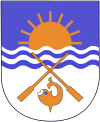Kotórz Wielki
| Kotórz Wielki Groß Kottorz | |
|---|---|
| Village | |
|
| |
 Kotórz Wielki Groß Kottorz | |
| Coordinates: 50°44′N 18°4′E / 50.733°N 18.067°E | |
| Country |
|
| Voivodeship | Opole Voivodeship |
| County | Opole County |
| Gmina | Turawa |
| Population (approx.) | 350 |
Kotórz Wielki [ˈkɔtuʂ ˈvjɛlki], German Groß Kottorz is a village in the administrative district of Gmina Turawa, within Opole County, Opole Voivodeship, in south-western Poland.[1] It lies approximately 2 kilometres (1 mi) south of Turawa and 12 km (7 mi) north-east of the regional capital Opole.
Before 1945 the area was part of Germany (see Territorial changes of Poland after World War II).
The village has an approximate population of 350.
History
The village was first documented in 1295 in the Liber fundationis episcopatus Vratislaviensis" as "Chotors".
The first wooden church for the village existed before 1293. At the initiative of Anna Barbara von Gaschin, construction began in 1782 for a new church for the village. Permission was given by the Bishop of Breslau on January 31, construction began in February, and by October the building was already covered with a roof. On a ball on the decorative spire of the church is written "Franz Herzog von Gaschin, highly born, married to Anna Barbara von Garnier, decided for the greater honor of God to give money to build a new church." The document ends "This document has been placed on this ball by me, Pastor Carl Padiery, for the good of future generations. The parish celebrated its 100th anniversary in 1882 though a small exhibition of documents detailing its history collected by its then-priest, Father Kahl, who was an avid scholar.
In 1840 the village had 385 inhabitants, and a large new school was built.
In the Upper Silesia plebiscite of 20 March 1921 164 villagers voted to remain with Germany and 164 voted to join the newly created state of Poland.[2] However, because citizens of Gemeinde Turawa overall voted for Germany, the village remained part of the Weimar Republic. In 1933 the village had 547 inhabitants. On 19 May 1936 the village was renamed Groß Kochen by Nazi officials because of its Slavic-sounding name. By 1939 the village had shrunk to only 474 inhabitants. Before 1945 it belonged to the district of Landkreis Oppeln
The village is situated near the Turawa Reservoir, which was began in 1933 with construction of the dam and then completed in 1938. During its contraction, 3 million cubic tons of earth were moved, 225 thousand tons of stone, 10 thousand tons of cement and the same amount of reinforced steel. The construction of the dam destroyed several villages, and villagers from three (Zamoscie, Krzysline, and Vorwerk Kuchara) were resettled in Groß Kottorz. However, it also brought development to the area.
After 1945, Silesia as a whole was annexed by Poland, and most of the German pollution was expelled. The village was renamed Kotórz Wielki. Though it originally placed in Silesian Voivodeship, in 1950 it was moved to Opole Voivodeship instead. On 8 March 2012, the old German name Groß Kottorz was again made official.
The town has a volunteer fire brigade, founded in 1934. It organizes may dances for the residents through the "Firemen's Club". It also organizes a traditional Silesian carnival known as "leading the bear" ("Wodzenie niedźwiedzia" in Polish, "Bährenführen" in German), through which it gets donations for maintenance. The building it is housed in is also home to the offices of the German Minority/German Cultural Association, which also holds events there.
References
Coordinates: 50°44′N 18°4′E / 50.733°N 18.067°E
